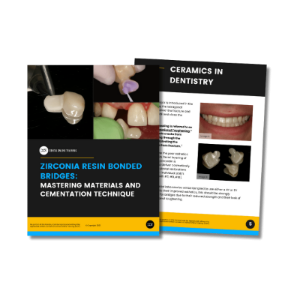What's inside?
CHAPTER 02
Single-wing vs two-wing
CHAPTER 04
Single-wing prep design
Zirconia Resin Bonded Bridges: The Key to Single-Wing Prep Design Success
Frequently asked questions
What is the significance of single-wing preparation design for zirconia resin bonded bridges?
Single-wing preparation design for zirconia resin bonded bridges is essential because it allows for a minimally invasive approach, preserving healthy tooth structure while achieving a stable and esthetically pleasing restoration.
How does minimally invasive dentistry contribute to successful zirconia resin bonded bridges?
Minimally invasive dentistry plays a significant role in successful zirconia resin bonded bridges by utilizing improved adhesives, cements, and restorative materials. This approach ensures a conservative tooth preparation, leading to better long-term outcomes for patients.
Why are dental implants in the esthetic zone not recommended for adolescent patients?
Dental implants in the esthetic zone are not recommended for adolescent patients due to anticipated facial growth during maturity. Implants placed during this growth phase may lead to unaesthetic results, as the implant crown may become offset from neighboring teeth.
What are the key requirements for achieving successful zirconia resin bonded bridges?
Key requirements for achieving successful Zirconia resin bonded bridges include a wing thickness of 0.7 - 1.0 mm, and a connector size of 7-9 mm for anterior 3Y zirconia bridges. Proper preparation techniques and smooth, rounded internal line angles are also crucial for optimal adaptation of the milled restoration.
How can clinicians ensure stability during the seating of zirconia resin bonded bridges?
To ensure stability during the seating of zirconia resin bonded bridges, clinicians may use preparation techniques like 'slots,' 'grooves,' or 'divots' in the tooth structure. Additionally, proper adhesive protocols and accurate laboratory communication contribute to a secure fit.
Are there specific preparation techniques or design variations for zirconia resin bonded bridges?
There is no universal agreement on the wing design for Zirconia resin bonded bridges, but various clinicians may utilize different techniques for stability during seating. However, the key focus remains on achieving the optimal wing thickness and connector size.
Why is effective laboratory communication crucial for optimal cosmetic outcomes with zirconia resin bonded bridges?
Effective laboratory communication is critical to achieving the best possible cosmetic outcome with zirconia resin bonded bridges. High-quality photographs and collaboration with dental ceramists help ensure a successful and esthetically pleasing final restoration.
Zirconia Resin Bonded Bridges: Mastering Materials and Cementation Technique Guide

Master the zirconia resin bonded bridge single-wing preparation design for optimal esthetic results.



